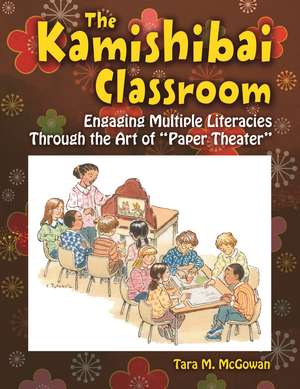The Kamishibai Classroom: Engaging Multiple Literacies Through the Art of "Paper Theater"
Autor Tara M. McGowanen Limba Engleză Paperback – 21 ian 2010 – vârsta până la 17 ani
Preț: 237.34 lei
Preț vechi: 305.57 lei
-22% Nou
Puncte Express: 356
Preț estimativ în valută:
45.42€ • 47.13$ • 37.96£
45.42€ • 47.13$ • 37.96£
Carte tipărită la comandă
Livrare economică 17-31 martie
Preluare comenzi: 021 569.72.76
Specificații
ISBN-13: 9781591588733
ISBN-10: 1591588731
Pagini: 120
Ilustrații: Illustrations
Dimensiuni: 216 x 279 x 8 mm
Greutate: 0.34 kg
Editura: Bloomsbury Publishing
Colecția Libraries Unlimited
Locul publicării:New York, United States
ISBN-10: 1591588731
Pagini: 120
Ilustrații: Illustrations
Dimensiuni: 216 x 279 x 8 mm
Greutate: 0.34 kg
Editura: Bloomsbury Publishing
Colecția Libraries Unlimited
Locul publicării:New York, United States
Caracteristici
Offers a pictorial history of kamishibai and how it evolved out of various etoki (picture-storytelling) traditions in Japan
Notă biografică
Tara M. McGowan is a doctoral candidate at the University of Pennsylvania in the Language and Literacy in Education division of the Graduate School of Education.
Cuprins
AcknowledgmentsIntroduction: Why Kamishibai? xiChapter 1-A Pictorial History of KamishibaiEarly Roots of KamishibaiUtsushi-e: Kamishibai's Direct AncestorFromUtsushi-e to Tachi-e: The First KamishibaiThe "New" KamishibaiThe New Kamishibai: Movies in MiniatureFurther ReadingChapter 2-The "Mechanics" of KamishibaiKamishibai as a Visual LiteracyA Kamishibai WorkshopAdapting the Workshop for Younger Children (Four to Seven Years Old)23EndnotesChapter 3-Using Kamishibai to Teach the Writing Process: Narrative Elements and Parts of SpeechUnderstanding Parts of Speech-Nouns and VerbsDetails! Details! Details!Understanding SequencingStory Structure at a GlanceClimax and SuspenseThe Magic of ThreeDeveloping a Sense of Pacing: Introducing AdverbsThe Power of Ma, or the Effective PauseEditing Made EasyCharacter and Voice-Adjectives!Voice and Emotional TonePoint of View and Interior MonologueSound Effects and OnomatopoeiaMood and Setting-Opening the CurtainThe Writing ProcessEndnotesChapter 4-Participatory Kamishibai: Playing with Language and Literacies. . .Lessons from the Gaito Kamishibai-yaKamishibai as an Interactive Storytelling FormBrain-teasers, Quizzes, Puzzles, and RiddlesOther Word Games: Shiritori and Thematic ABCsKirinuki: Cutout Kamishibai Peep ShowsVisual Perspective and Withholding InformationA Keyhole onto CultureChapter 5-The Personal Story or "Memoir"The SituationCharacterSettingResolutionThe Bridge to the Writing ProcessEndnotesChapter 6-Kamishibai in the Social Studies and Science Curriculum: Defining a Sense of CommunityBuilding a Sense of Community and Local CultureThe Role of Research: Drawing as a Way of SeeingAn Ecological PerspectiveThe Spirit of the Tea Ceremony and the Problem of the StoryBridging Two Worlds Through the Life of ObjectsBringing the Audience into the StoryThe Spirit of the StoryEndnotesConclusion: Creating a Kamishibai CultureAppendix: Stage InstructionsReferencesIndex














